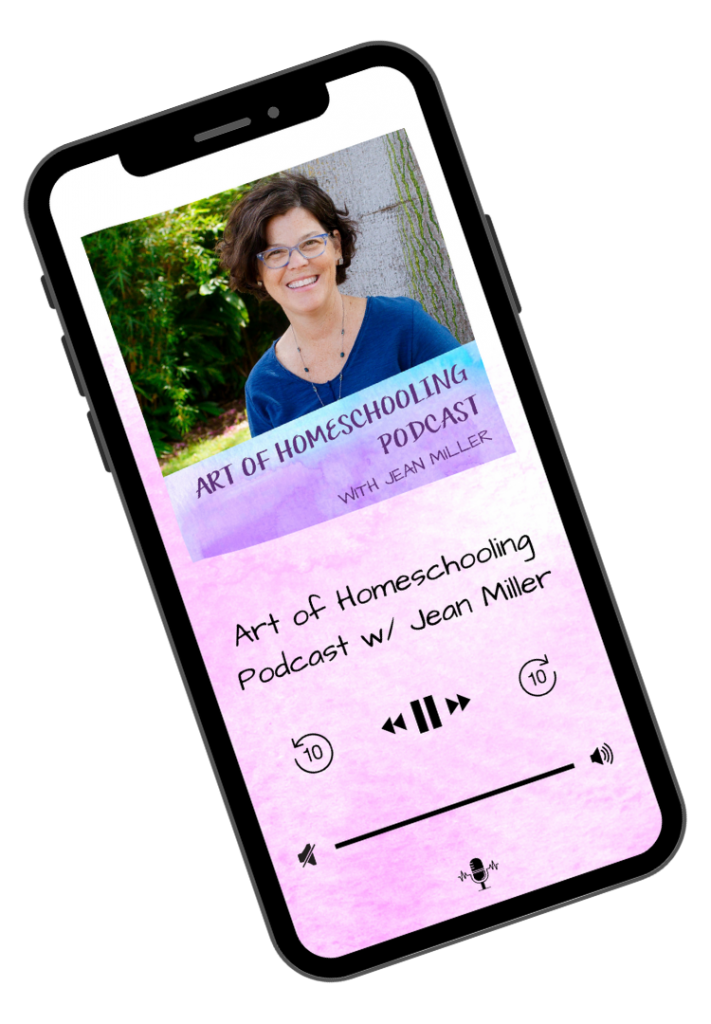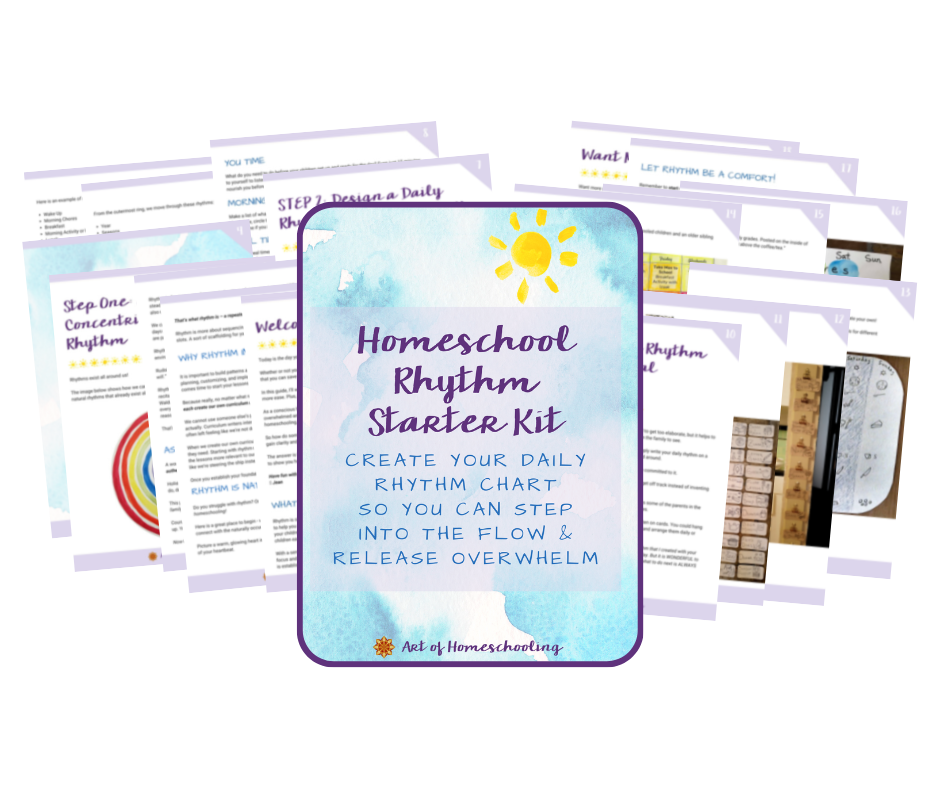Episode 127
Homeschool lesson planning is a grounding practice that calls on us to consider where we are, where we want to be, and how we might get there with our kiddos.
Having a lesson plan may be less useful than you think!
Let’s talk about it. This episode of the Art of Homeschooling podcast is all about how to make homeschool lesson planning work for YOU.
As a former public school teacher, I can tell you that there is nothing that a classroom teacher dreads more than sitting down for three hours on a Sunday night to write pages of detailed lesson plans.
But when we started homeschooling, I actually wanted some kind of lesson plan, believe it or not. I felt lost without a plan or outline on paper. The planning process itself became so valuable to me.
“Plans are useless, but planning is indispensable.”
~President eisenhower
So how do you make a homeschool lesson plan?
Homeschool Lesson Planning for the Year
The first step is considering the year as a whole. Our homeschool lesson plans are part of a bigger vision for our children, our family, and our homeschooling path.
My signature homeschool lesson planning method has six simple steps.
These steps form the acronym for B.R.I.D.L.E. Because to me, planning is a way of reining in our wild ideas and imaginations ~ making them more concrete and doable.
Here are the steps:
- Blocks ~ where you map out your block topics for each month of the year
- Resources & Rhythm ~ where you create a calendar for the year and then choose resources
- Inner Work ~ where you make a plan for taking care of yourself
- Daily Rhythm ~ where you create a chart of the flow of your daily activities
- Lively Art Lessons ~ where you actually create your plans
- Environment ~ where you set up your materials and space
These are the exact steps I created for myself so that I could see the whole of the year AND THEN design lessons that fit into that larger vision.
I lead homeschoolers through Plan It Out every summer! It’s part of the Inspired at Home membership and is scheduled to begin in June. OR you can access Plan It Out right away if you join the membership where the course is one of 30+ courses and masterclasses available to you in a library of trainings.
Thoughts About Planning for Block Learning
Block learning is the simplest way to plan your homeschooling year and allows for a more immersive experience for both the child and parent.
Here are a few things to keep in mind about planning for block learning.
Block plans can provide a guide or a menu for teaching and learning over several weeks or a month. And as home educators, we’re often learning right along with our children.
It may take time to build momentum for a new block topic. In fact, it’s okay if you don’t have your whole block planned out when you begin.
Teaching one topic or theme over a month or more gives you time, space, and flexibility to build up the topic, find what’s most interesting to you and your children, and gather materials as you go.
This is especially true for topics like geography, history, and the sciences.
Teaching with blocks allows you, as the home educator, to find some aspect of the topic that sparks your own imagination and interest. Modeling this for your children is so valuable.
There are also blocks that focus on literature or stories such as fairy tales or fables. Teaching with stories in a block of several weeks gives you a chance to live deeply into these imaginative realms.
You might even begin to see the stories, characters, or themes magically emerge in your children’s free play, free writing, or free drawing as the stories come to life for them.
Lastly, teaching in blocks gives your child milestones to remember. When we’re homeschooling, the lessons and life often blend together into one beautiful journey. Your child can look back as he or she grows up and remember certain blocks or stories and topics that marked events or achievements for them.
Homeschool Lesson Planning for Each Week or Day
So now let’s talk about what lesson planning looks like after you’ve created your vision for the year and thought about what blocks or topics you’ll be teaching.
And here’s where we get down to the essentials of daily lesson planning!
In keeping with my philosophy for simple, inspiring, and doable homeschooling, I like to create a simple outline for each day. You can do this on a calendar, in a teacher planner, or in a planning binder that you create yourself (my favorite!).
In this binder, you might have tabs for each month or each block topic. Then you can add pages that show a week at a time and include the basic outline for your daily activities with your kiddos.
A simple, doable lesson plan outline might include:
- Stories or books you’ll share
- Songs, verses, and movement games or activities you’ll use to warm up
- Summaries you’ll write
- Drawings you’ll include
Building Blocks Around One Book
Homeschool lesson planning can be as simple as creating a block for your whole family using one wonderful read-aloud book.
Books can provide a theme for art, activities, and adventures for multiple ages. And you can still deliver lessons in an individual way to each child while building a family culture of loving learning and literature.
Because I hear from so many homeschoolers who love this simple way of planning the lessons for their homeschools, my friend and colleague Alison Manzer and I have teamed up to offer you the Book Hearth. Check it out!
Resources for Homeschool Lesson Planning
I want you to remember that homeschool lesson planning doesn’t have to be complicated. You CAN find a way that works for you to keep lesson planning simple, inspiring, and doable.
Here are some more suggested resources to explore from the Art of Homeschooling:
- Put together a homeschool lesson planning binder with the beautiful planning templates from our Holistic Planning Pack. Using the suggested planning steps, you create a big picture plan for the year, a block plan overview, and a weekly rhythm. Then choose any of the weekly lesson plan templates to customize your lesson planning.
- Listen to Episode #122: Homeschool Block Schedule to hear more about creating a big picture plan for your homeschool blocks.
- Episode #107: Main Lesson Block Learning explores what main lesson blocks are, why main lesson block learning works, and the difference between main lesson blocks and unit studies.
- You’ll learn three tools to strengthen your block teaching in Episode #90: Block Learning is Fantastic for Homeschooling, And Here’s Why.
Rate & Review the Podcast
If the Art of Homeschooling Podcast has inspired you, I’d LOVE it if you could rate and review the podcast on your favorite podcast player! Reviews can be left on Apple Podcasts (iTunes), Podcast Addict, or Stitcher.
Or simply pop on over to lovethepodcast.com/artofhomeschooling and choose where you want to leave your review.
And if you want to show your appreciation for the Art of Homeschooling Podcast, you can buy me a coffee!
Never Miss an Episode!


Check Out All the Episodes Here



